How to Cut Green Onions
Are you ready to become a master at cutting green onions? In this comprehensive guide, I will walk you through the step-by-step process of how to cut green onions, from prepping to different cutting techniques. Whether you’re slicing, chopping, dicing, or mincing green onions, you’ll learn everything you need to know to handle them like a pro.
Before we dive into the actual cutting process, let’s understand why cutting green onions properly is important. Mastering the right knife skills and following safety guidelines not only enhances your cooking experience but also ensures consistent results.
How to Cut Green Onions – Key Takeaways:
- Learn the step-by-step process of cutting green onions
- Understand the importance of proper green onion preparation
- Discover different cutting techniques for garnishing, cooking, and more
- Explore the versatility of green onions in various recipes
- Find out about the nutritional benefits of green onions
Why Cutting Green Onions Properly Is Important
When it comes to cooking with green onions, mastering the right knife skills and following safety guidelines is essential. Properly cutting green onions not only enhances your overall cooking experience but also ensures consistent results in your dishes. So, let’s delve into the importance of green onion knife skills, cutting techniques, and cutting safety.
Green Onion Knife Skills: Precision and Control
Having good knife skills is crucial for cutting green onions effectively. A sharp knife allows for precise cuts, ensuring clean edges and avoiding unnecessary damage to the onion. By maintaining control over your knife, you can achieve uniform and even slices, slices, dices, or minces of green onions, resulting in visually appealing dishes.
Cutting Techniques: Versatility and Flavor
Understanding different cutting techniques for green onions opens up a world of culinary possibilities. Slicing green onions into rings provides a beautiful garnish for salads and soups, while chopping them into matchsticks adds a flavorful crunch to stir-fries. Dicing green onions in julienne style brings a burst of freshness to recipes. And mincing green onions releases intense flavor when used as a seasoning. Knowing these techniques allows you to create a variety of dishes with different textures and tastes.
Cutting Safety: Protecting Yourself and Others
While cutting green onions can be enjoyable, safety should always be a top priority. Using proper cutting techniques and tools reduces the risk of accidents and injuries in the kitchen. Remember to grip the knife firmly, keep your fingers away from the blade, and cut on a stable surface. By following safety guidelines, you can ensure a safe and pleasant cutting experience while preparing your favorite dishes.
Summary – How to Cut Green Onions
Mastering the art of cutting green onions involves developing knife skills, learning different cutting techniques, and prioritizing safety. By practicing precision and control, you can achieve visually appealing slices, dices, or minces. Exploring a variety of cutting techniques adds versatility and flavor to your dishes. And, most importantly, prioritizing safety protects both yourself and others in the kitchen. So, sharpen those knives, get ready to chop, and unleash the vibrant flavors of green onions in your culinary creations.
The Importance of Green Onion Preparation
Before diving into the process of cutting green onions, it is crucial to properly prepare them to ensure the best flavor and texture in your dishes. This step-by-step guide will show you how to trim and remove unwanted parts, leaving you with perfectly prepped green onions.
Trimming Green Onions
Begin by rinsing the green onions under running water to remove any dirt or debris. Then, lay them on a cutting board and examine for wilted or damaged pieces. Remove these by cutting off about ¼ of an inch from both ends.
To remove the fuzzy root end, make a straight cut just above the root, ensuring that you remove any brown or discolored parts. This will give your green onions a fresh and clean base.
Removing Green Onion Roots
Next, locate the point where the green parts begin to branch off from the white base. Make a cut at this junction, separating the green and white parts. The green parts can be sliced for garnish, while the white parts are typically used for cooking.
By properly trimming the ends and removing the roots, you’ll have green onions that are ready to be sliced, chopped, or diced for your culinary creations. Enjoy the fresh and vibrant flavors that green onions bring to your dishes.
| Section | Details |
|---|---|
| Step 1 | Rinse the green onions under running water |
| Step 2 | Trim ¼ inch from both ends to remove wilted pieces |
| Step 3 | Remove the fuzzy root end by making a straight cut above the root |
| Step 4 | Locate the junction where the green parts begin to branch off from the white base and make a cut at this point |
Step-by-Step Guide: How to Cut Green Onions
In this section, I will walk you through the step-by-step process of cutting green onions. By following these simple steps, you’ll be able to handle green onions with ease and precision.
Factual Data: How to Cut Green Onions
To cut green onions, start by rinsing them under running water and removing any wilted pieces or bad layers. Then, trim off ¼ of an inch from both ends, removing the fuzzy root end and the broken, tough green ends. Locate the junction where the green parts begin to branch off from the white base and make a cut at this point. The green parts can be used for garnish and the white parts for cooking.
Next, let’s talk about different cutting methods for green onions. If you want to slice the green parts, use a push-pull or circular motion with a sharp knife to avoid breaking them. This technique is perfect for garnishing dishes and adding a fresh, vibrant touch. For cooking purposes, chopping the white parts into small pieces or matchsticks works well.
Whether you’re making salads, soups, stir-fries, or any other recipe that calls for green onions, the versatile nature of this ingredient allows you to use it in various ways. Experiment with different dishes and explore how green onions can enhance the flavors and textures of your creations.
| Green Onion Cutting Steps |
|---|
| Rinse green onions under running water. |
| Remove wilted pieces and bad layers. |
| Trim off ¼ of an inch from both ends. |
| Locate the junction and make a cut. |
| Slice or chop according to your recipe needs. |
To store green onions, you can refrigerate them in a glass jar filled with water to keep them fresh and crisp. Alternatively, wrap them in a damp paper towel and place them in a plastic bag. Proper storage will ensure that you can enjoy the full flavor and texture of green onions whenever you need them.
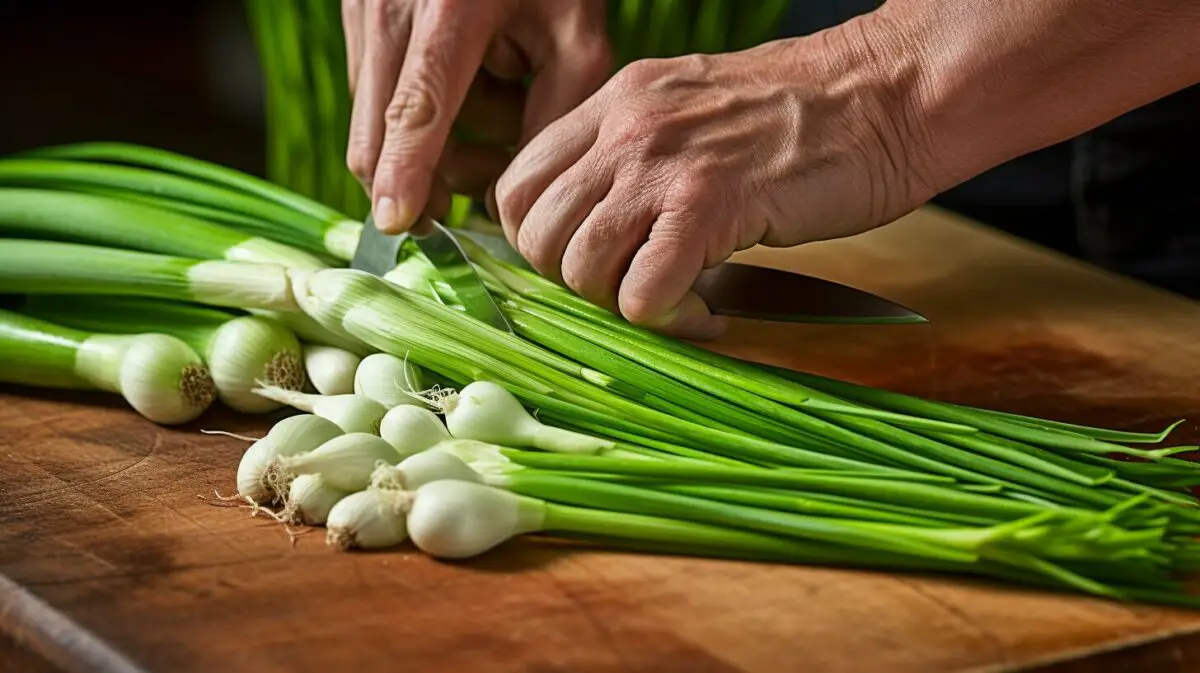
Now that you have mastered the art of cutting green onions, you can confidently handle this ingredient in any recipe. The techniques and tips shared in this guide will help you achieve consistent and professional results. So, go ahead and start incorporating green onions into your cooking adventures!
Slicing Green Onions for Garnish
In this section, I will guide you through the process of slicing green onions for garnish. Slicing green onions into beautiful, uniform rings can add a touch of elegance to your dishes and enhance their visual appeal. Follow these simple steps to achieve perfect green onion rings every time.
Step 1: Preparing the Green Onions
Start by rinsing the green onions under running water to remove any dirt or debris. Then, using a sharp knife, trim off about ¼ of an inch from both ends. This step will ensure that you’re working with fresh, clean green onions.
Step 2: Making the Cuts
Locate the junction where the green parts of the green onions begin to branch off from the white base. This is the point where you want to make your cuts. To slice the green parts, use a sharp knife and a push-pull or circular motion. Avoid applying too much pressure, as this can cause the green onions to break or lose their shape.
Step 3: Using the Green Onion Rings
Now that you have perfectly sliced green onion rings, it’s time to put them to use. These rings can be used as a garnish for various dishes, such as salads, soups, stir-fries, and more. Their vibrant green color and mild onion flavor will add a refreshing touch to your culinary creations.
Remember to store any unused green onion rings properly to maintain their freshness. Refrigerate them in a glass jar filled with water, or wrap them in a damp paper towel and place them in a plastic bag. This will help to preserve their crispness and flavor for longer.
| Benefits of Slicing Green Onions for Garnish | Best for |
|---|---|
| Enhances visual appeal of dishes | Salads, soups, stir-fries |
| Provides a refreshing onion flavor | Various culinary creations |
| Easy to store and preserve freshness | Refrigerator in a glass jar with water or wrapped in a damp paper towel |

“Slicing green onions into beautiful, uniform rings can add a touch of elegance to your dishes and enhance their visual appeal.”
Chopping Green Onions for Cooking
When it comes to cooking, chopping green onions into matchsticks is a versatile technique that can add a burst of flavor to your dishes. To get started, rinse the green onions under running water to remove any dirt or debris. Next, it’s important to trim off ¼ of an inch from both ends of the green onions. This will ensure that you’re working with the freshest and tastiest parts of the vegetable.
Once you’ve trimmed the ends, locate the junction where the green parts begin to branch off from the white base. Make a cut at this point to separate the green and white portions of the green onion. The green parts can be set aside for garnish, while the white parts are perfect for cooking.
To chop the white parts into matchsticks, lay the green onion flat on the cutting board and slice it lengthwise. Then, turn the green onion so that the flat side is facing down and make thin, lengthwise cuts across the width of the onion. This will create small, uniform matchstick pieces.
Chopped green onions can be used in a variety of dishes, such as soups, stir-fries, omelettes, and more. Their mild onion flavor adds depth to recipes without overpowering other ingredients. So, the next time you’re in the kitchen, try chopping green onions into matchsticks and unlock a world of delicious possibilities.
Green Onion Cutting Styles
When it comes to cutting green onions, there are several styles you can experiment with to suit your culinary needs. Here are a few popular cutting styles:
- Bias Cut: This cutting style involves slicing the green onions at an angle, creating diagonal pieces. Bias cuts are often used for garnishing or adding visual interest to dishes.
- Round Cut: In this style, the green onions are cut into small, circular pieces. Round cuts are commonly used in salads or as a topping for soups.
- Slant Cut: Similar to the bias cut, the slant cut involves making angled slices. Slant cuts provide a unique presentation and can be used in various recipes.
Experimenting with different cutting styles can not only enhance the visual appeal of your dishes but also add different textures and flavors. So, don’t be afraid to get creative and try out these cutting styles with your green onions!
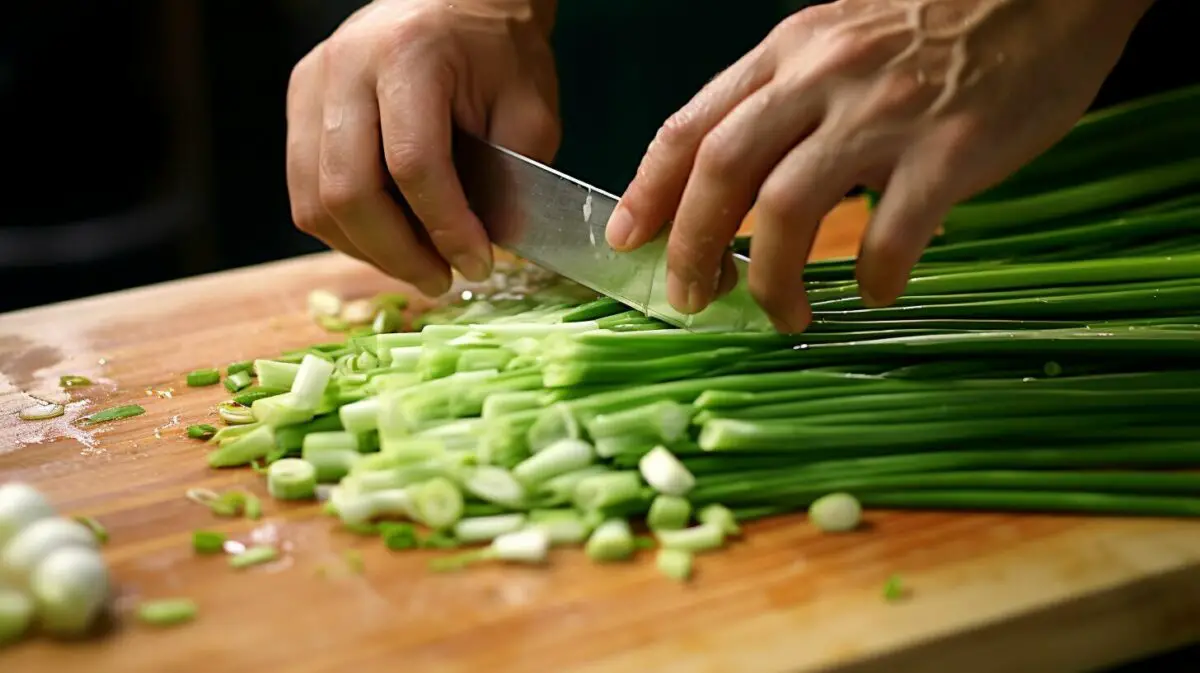
When it comes to adding a delightful crunch and flavor to your dishes, diced green onions are a perfect choice. Whether you’re making a stir-fry, soup, or salad, mastering the art of dicing green onions will take your recipes to the next level. Here’s how to julienne green onions and explore different cutting options for a burst of freshness and aroma.
To begin, rinse the green onions under running water to remove any dirt or debris. Then, trim off ¼ of an inch from both ends, ensuring you remove the fuzzy root end and any broken or tough green ends. Next, locate the junction where the green parts begin to branch off from the white base. Make a clean cut at this point to separate the green and white parts.
Once you have separated the green and white parts, focus on the green parts for dicing. Stack the green onion pieces together and hold them firmly with one hand. Use a sharp knife to make thin, even slices across the length of the green onion. This will create long, thin strips.
Finally, gather the strips together and make perpendicular cuts to create small, uniform pieces. The result will be finely diced green onions, ready to add a burst of flavor and visual appeal to your dishes. Whether you’re garnishing a bowl of soup or tossing them into a stir-fry, diced green onions are a versatile ingredient that adds a touch of freshness to your culinary creations.
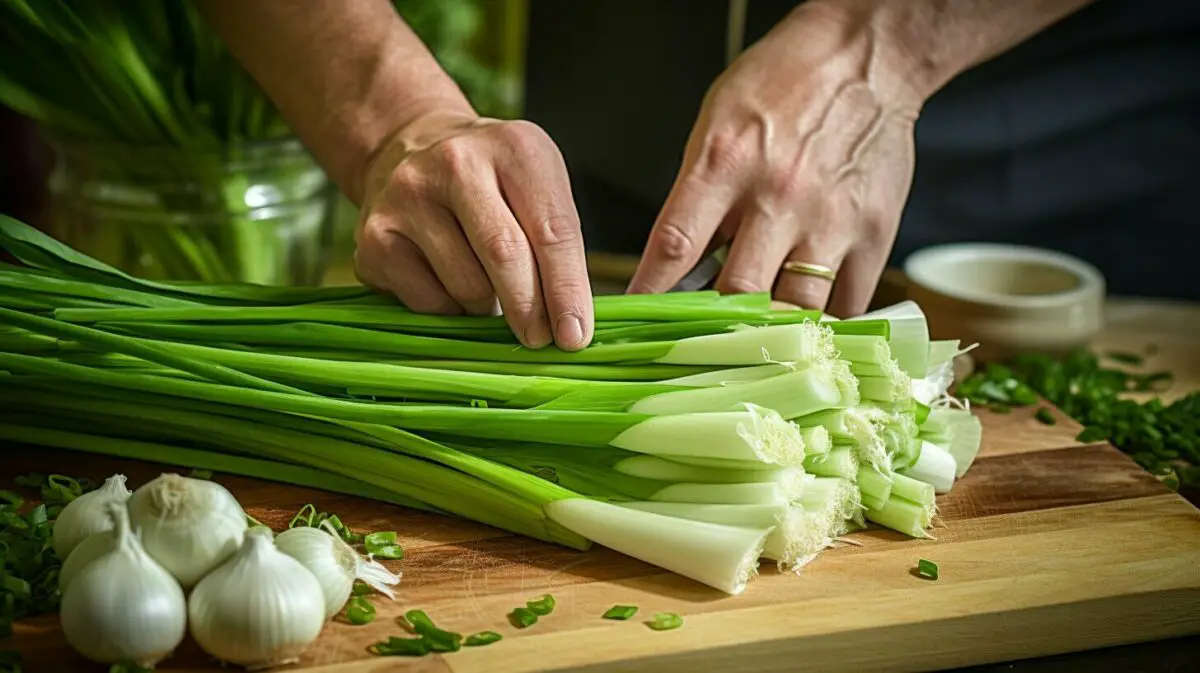
| Benefits of Dicing Green Onions | How to Use Diced Green Onions |
|---|---|
|
|
“Diced green onions are a versatile ingredient that adds a burst of flavor and visual appeal to your dishes.”
Experiment with Dicing Styles
Don’t be afraid to get creative with your dicing techniques. Depending on the recipe or the visual effect you want to achieve, you can vary the size and shape of your diced green onions. Consider trying these different options:
- Fine dice: For a delicate and subtle presence, dice the green onions into small, uniform pieces.
- Chunky dice: If you prefer more texture and bite, create larger, irregular-sized pieces.
- Diagonal dice: For a visually appealing presentation, cut the green onions at a slight angle to create diagonal pieces.
Remember, the key to dicing green onions is to maintain consistency in size so that they cook evenly and distribute their flavors throughout your dish. So why not let your creativity shine and experiment with different cutting styles to elevate your culinary creations?
Green Onion Cutting Tricks and Advice
In this section, I will share some expert tips and tricks to help you achieve perfect results when cutting green onions. Whether you’re slicing them for garnish, chopping them for cooking, or mincing them for intense flavor, these techniques will elevate your culinary skills to new heights.
Before we delve into the specific cutting methods, let’s start with the basics. When preparing green onions, it’s important to rinse them under running water and remove any wilted pieces or bad layers. Afterward, trim off ¼ of an inch from both ends, eliminating the fuzzy root end and the broken, tough green ends. This step ensures that you’re working with fresh and clean green onions.
Next, locate the junction where the green parts begin to branch off from the white base. Make a clean cut at this point, separating the white and green parts. The white parts are perfect for cooking, while the green parts can be used as a garnish. By understanding the different uses for each part, you can maximize the versatility of green onions in your recipes.
When it comes to slicing the green parts, it’s essential to use a sharp knife and employ a push-pull or circular motion. This technique prevents the green onions from breaking and ensures uniform slices. Remember, presentation matters, and beautifully sliced green onions can elevate the visual appeal of your dishes.

Now that you have mastered the art of cutting green onions, it’s time to explore the endless possibilities that this versatile ingredient offers. Green onions can add a burst of freshness and flavor to salads, soups, stir-fries, and many other dishes. Get creative and experiment with different recipes to fully appreciate the culinary magic of green onions.
When it comes to storing green onions, there are a couple of options. One method is to refrigerate them in a glass jar filled with water. This keeps the green onions hydrated and fresh for longer. Alternatively, you can wrap them in a damp paper towel and place them in a plastic bag. Both methods help maintain the crispness and flavor of green onions, ensuring that they are always ready to enhance your culinary creations.
Green Onion Cutting Tricks and Advice: Summary
- Rinse green onions under running water and remove wilted pieces or bad layers.
- Trim off ¼ inch from both ends, eliminating the root end and the tough green ends.
- Locate the junction where the green parts branch off from the white base and make a clean cut.
- Slice the green parts using a sharp knife and a push-pull or circular motion.
- Explore the versatility of green onions in various recipes, from salads to stir-fries.
- Store green onions in a glass jar filled with water or wrap them in a damp paper towel and place them in a plastic bag.
With these cutting tricks and advice, you can confidently handle green onions like a pro and enhance your culinary creations with their vibrant flavors.
Storing Green Onions for Freshness
Properly storing green onions is essential to maintain their freshness and flavor. Whether you have an abundance of green onions from your garden or simply want to prolong their shelf life, here are some effective methods to keep your green onions crisp:
- Refrigerate in a Glass Jar with Water: Fill a glass jar with about an inch of water and place the green onions in it, root side down. Cover the jar loosely with a plastic bag or wrap. This method helps maintain the moisture and crispness of the green onions.
- Wrap in a Damp Paper Towel: If you prefer not to use water, you can wrap the green onions in a damp paper towel. This helps prevent wilting and keeps the onions hydrated. Place the wrapped green onions in a plastic bag or airtight container.
- Avoid Freezing: While you can freeze many vegetables, green onions are best used fresh. Freezing can affect their texture and flavor, so it’s recommended to use them within a week or two of purchase.
By following these storage methods, you can enjoy fresh, flavorful green onions for an extended period. Incorporate them into your favorite recipes, such as salads, soups, stir-fries, and more, to add a delightful crunch and flavor to your dishes.
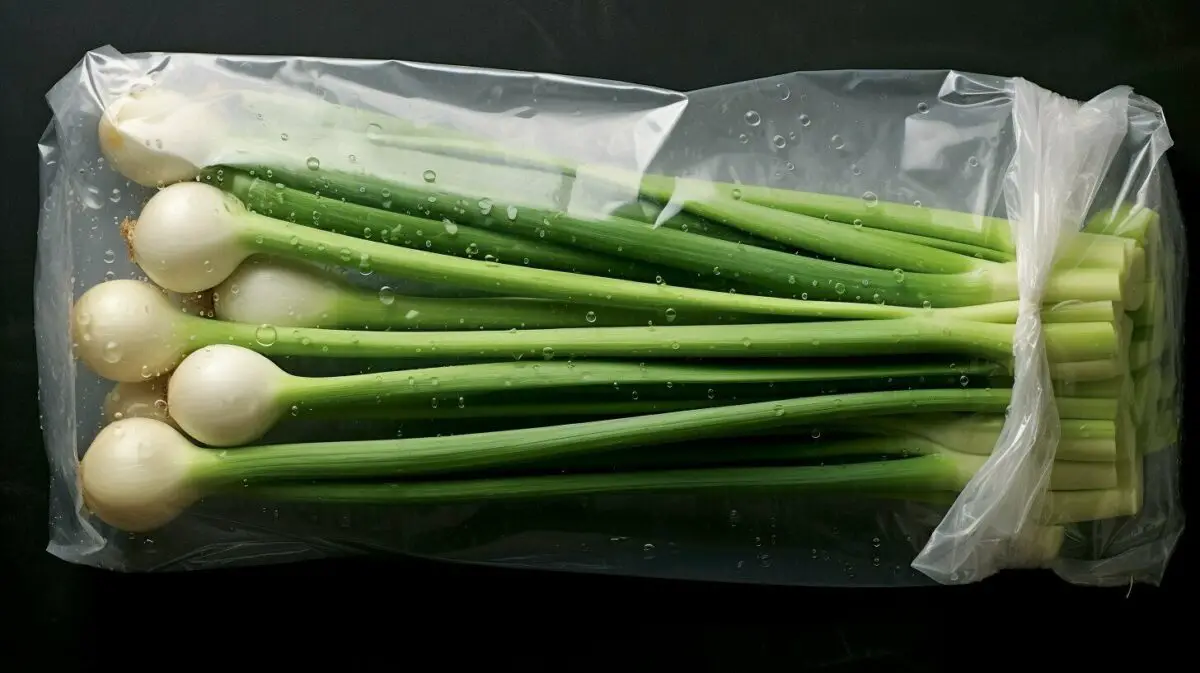
Table 1: Comparison of Green Onion Storage Methods
| Storage Method | Pros | Cons |
|---|---|---|
| Refrigerating in a Glass Jar with Water | Maintains moisture and crispness | Requires a glass jar and plastic bag/wrap |
| Wrapping in a Damp Paper Towel | Prevents wilting and keeps onions hydrated | Requires a plastic bag or airtight container |
| Avoiding Freezing | Preserves texture and flavor | Best used within a week or two of purchase |
Remember, storing green onions properly ensures they stay fresh and ready to enhance your culinary creations. So, the next time you buy a bunch of green onions or harvest them from your garden, employ these storage methods to enjoy their vibrant flavors for as long as possible.
Exploring the Versatility of Green Onions
Green onions, also known as scallions or spring onions, are a versatile ingredient that can add a burst of flavor and freshness to your dishes. Whether you’re cooking up a stir-fry, making a salad, or garnishing your favorite soup, green onions can elevate the taste and presentation of your meals. Let’s explore some delicious green onion recipes and discover the various ways you can incorporate this versatile ingredient into your cooking.
1. Green Onion Pancakes: Green onion pancakes are a savory and crispy treat that can be enjoyed as an appetizer, snack, or side dish. Made with a simple dough infused with chopped green onions, these pancakes are pan-fried to perfection. Serve them with a dipping sauce for a delightful culinary experience.
2. Green Onion Soup: If you’re a fan of classic French onion soup, why not give it a twist by using green onions instead? Their mild and slightly sweet flavor adds a unique element to the soup. Simply sauté sliced green onions in butter, add vegetable or chicken stock, and let the flavors meld together for a comforting bowl of soup.
3. Green Onion Fried Rice: Transform your leftover rice into a delicious and flavorful meal by adding green onions. Sauté green onions in a hot skillet with some oil, then stir in cooked rice, soy sauce, and your choice of protein or vegetables. Toss everything together until well combined, and you’ll have a tasty and satisfying fried rice dish.
Green Onion Infographic:

| Benefits of Green Onions | Uses of Green Onions |
|---|---|
|
|
“Green onions add a burst of freshness and flavor to a wide range of recipes. From pancakes and soups to stir-fries and fried rice, the possibilities are endless. Get creative in the kitchen and let green onions enhance your culinary creations.”
The Nutritional Benefits of Green Onions
When it comes to adding flavor and nutrition to your meals, green onions are a fantastic choice. These versatile vegetables offer a range of health benefits and can be incorporated into a variety of dishes. Let’s dive into the nutritional benefits of green onions and discover why they should be a staple in your kitchen.
Green onions are low in calories and high in essential nutrients. They are a great source of vitamins, including vitamin C, vitamin K, and vitamin A. These vitamins play a crucial role in boosting your immune system, supporting healthy vision, and promoting bone health. Green onions also contain folate, a B-vitamin that is important for cell growth and development.
In addition to vitamins, green onions are rich in minerals such as potassium, calcium, and magnesium. Potassium helps to maintain a healthy heart and regulate blood pressure, while calcium and magnesium contribute to strong bones and teeth. These minerals are essential for overall well-being and optimal bodily function.
Furthermore, green onions contain antioxidants and compounds that have been linked to various health benefits. One such compound is quercetin, which has anti-inflammatory and anti-cancer properties. Green onions also contain sulfur compounds that may have antimicrobial and cardiovascular benefits.
The Nutritional Benefits of Green Onions
| Nutrient | Amount per 100g |
|---|---|
| Calories | 32 |
| Protein | 1.8g |
| Fat | 0.4g |
| Carbohydrate | 7.3g |
| Fiber | 2.6g |
| Vitamin C | 13.2mg |
| Vitamin K | 207µg |
| Vitamin A | 145µg |
| Potassium | 276mg |
| Calcium | 72mg |
| Magnesium | 20mg |
As you can see, green onions pack a nutritional punch in a small package. So, next time you’re planning a meal, consider adding green onions for their delicious flavor and health benefits. Whether you toss them in a salad, stir-fry them, or use them as a garnish, green onions are a valuable addition to any dish. Enjoy the vibrant flavors and reap the rewards of the nutritional benefits they offer.
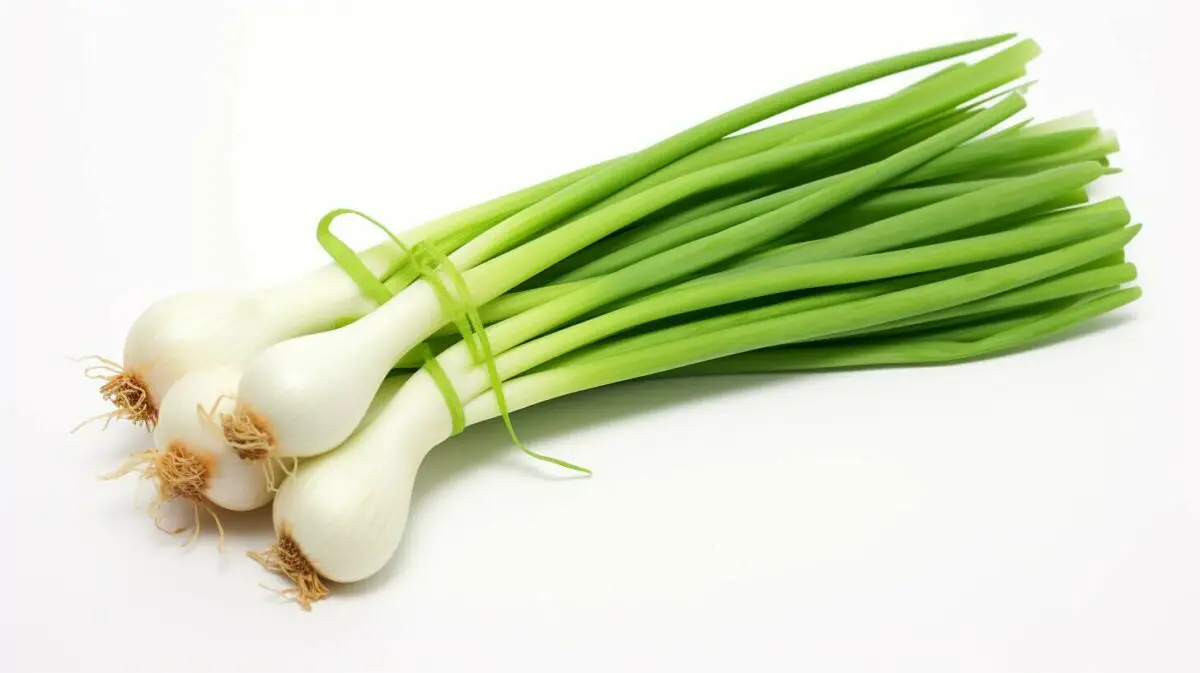
Safety Measures When Cutting Green Onions
When it comes to cutting green onions, safety should always be a top priority. Follow these essential safety measures to ensure a safe and enjoyable cutting experience:
- Use a sharp knife: A sharp knife is safer to use than a dull one. It requires less force, reducing the risk of slips and accidents. Make sure to keep your knife properly sharpened.
- Secure your cutting surface: Place a damp kitchen towel or a non-slip cutting mat under your cutting board to prevent it from sliding around while you work.
- Adopt a stable cutting stance: Stand with your feet shoulder-width apart and keep your body balanced and stable. This will help you maintain control over your knife and prevent any accidental slips or falls.
- Hold the knife correctly: Grip the knife handle firmly but not too tightly. Your thumb and index finger should be on opposite sides of the blade, forming a secure grip.
- Pay attention to your fingers: Always curl your fingers under and hold the food item with your knuckles against the side of the knife. This technique, known as the “claw grip,” helps protect your fingers from accidental cuts.
- Work at a comfortable pace: Rushing while cutting can lead to accidents. Take your time and focus on the task at hand, ensuring each cut is deliberate and controlled.
By following these safety measures, you can enjoy the process of cutting green onions while minimizing the risk of accidents. Remember, safety should always come first when working with knives in the kitchen.
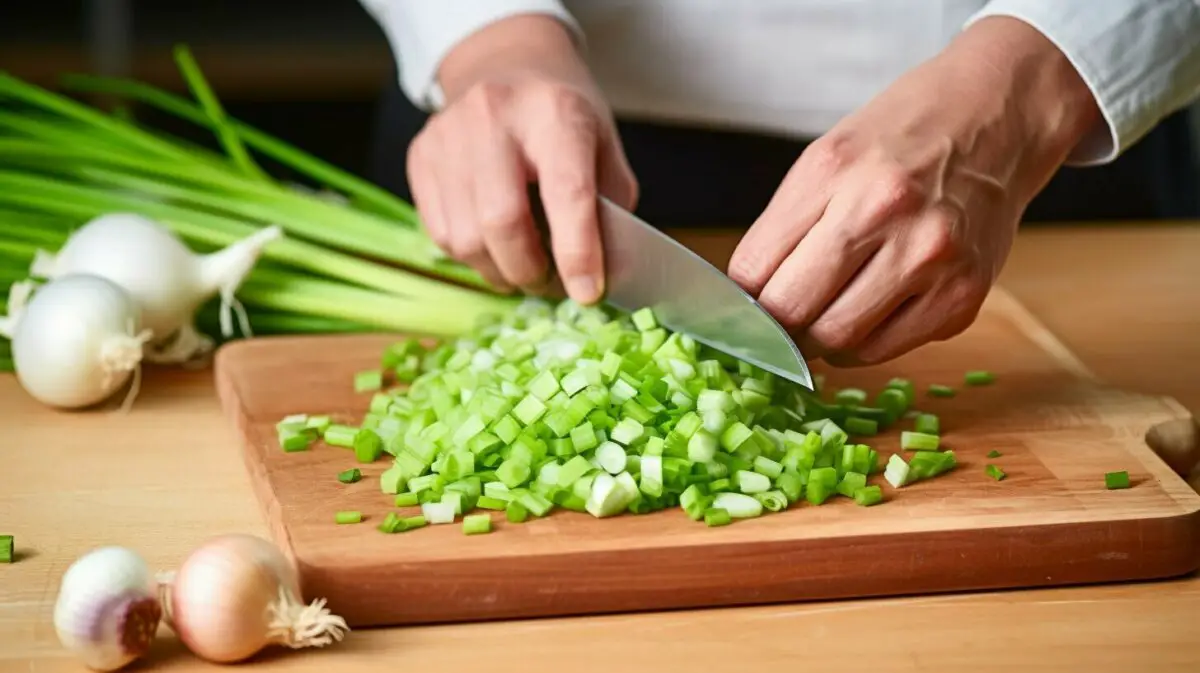
| Safety Measure | Advantages |
|---|---|
| Use a sharp knife | Reduces the risk of slips and accidents |
| Secure your cutting surface | Prevents the cutting board from sliding |
| Adopt a stable cutting stance | Ensures control and prevents slips or falls |
| Hold the knife correctly | Provides a secure grip |
| Pay attention to your fingers | Protects fingers from accidental cuts |
| Work at a comfortable pace | Minimizes the risk of accidents |
Common Mistakes to Avoid When Cutting Green Onions
When it comes to cutting green onions, there are a few common mistakes that can hinder your slicing and dicing skills. By avoiding these errors, you’ll be on your way to perfectly cut green onions every time. Here are some tips to help you navigate the cutting process:
- Using a dull knife: A sharp knife is essential for clean, precise cuts. Avoid using a dull knife, as it can crush the onion instead of cutting through it. Ensure your knife is sharp before starting the cutting process.
- Not separating the white and green parts: Green onions consist of a white base and green tops, each with its own unique flavor and texture. To maximize their potential in your dishes, make sure to separate the white and green parts and use them accordingly.
- Not paying attention to the cutting angle: To achieve a consistent cut, pay attention to the angle at which you’re slicing. Cutting on a bias (diagonal angle) can enhance the visual appeal of your dishes, while cutting straight across provides stability.
- Rushing the cutting process: Cutting green onions requires a certain level of precision and focus. Avoid rushing through the process to prevent uneven cuts or potential accidents. Take your time and enjoy the art of cutting.
By keeping these tips in mind, you’ll be able to cut green onions like a pro, ensuring beautiful presentation and optimal flavor in your dishes. Remember, practice makes perfect, so don’t be discouraged if it takes a few tries to master the art of cutting green onions.
“A sharp knife and patience are the keys to mastering the art of cutting green onions.” – Professional Chef
Summary – How to Cut Green Onions
Cutting green onions can be a breeze with the right techniques and attention to detail. Avoid common mistakes such as using a dull knife, not separating the white and green parts, neglecting the cutting angle, and rushing the process. By honing your skills and practicing regularly, you’ll be able to achieve consistent, clean cuts that enhance the flavor and presentation of your dishes.
Remember, cutting green onions is an art that requires patience and precision. So take your time, enjoy the process, and let the vibrant flavors of green onions shine in your culinary creations.
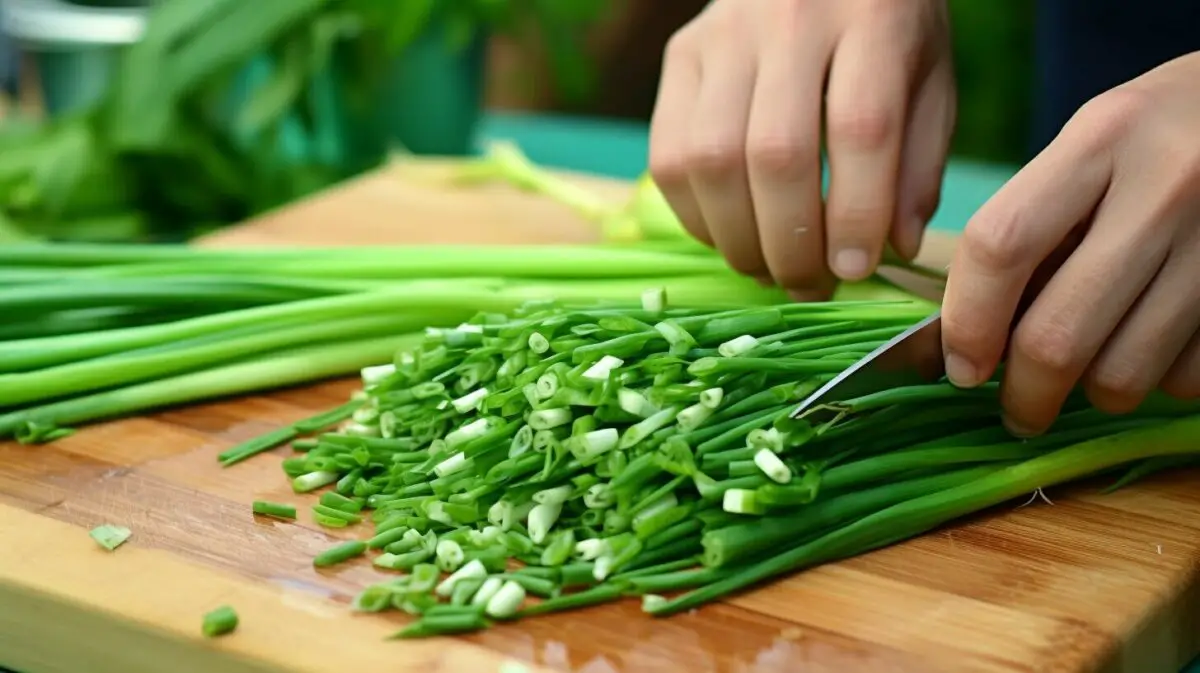
Once you have finished cutting green onions, it’s important to clean up your workspace to maintain a tidy and organized kitchen. Follow these simple steps to ensure a hassle-free cleanup process:
- Gather all your green onion trimmings and dispose of them in a compost bin or food waste disposal system. This will help minimize kitchen odors and keep your workspace clean.
- Wipe down your cutting board with warm, soapy water to remove any lingering onion residue. Use a scrub brush or sponge to remove any stubborn stains or debris.
- Clean your knife with warm water and dish soap. Be sure to pay extra attention to the blade, removing any onion bits that may have gotten stuck. Dry the knife thoroughly to prevent rusting.
- Finally, clean your countertop or work surface with a disinfecting spray or wipe. Pay attention to any areas where green onion juices may have spilled.
By following these cleanup steps, you’ll ensure that your kitchen remains clean, hygienic, and ready for your next culinary adventure.
A clean kitchen is the foundation for a successful cooking experience.
Tips for Easy Cleanup:
- Work on a cutting board with a groove around the edges to catch any juices and prevent them from dripping onto your countertop.
- Consider using a separate cutting board for green onions to avoid transferring their strong aroma to other ingredients.
- Keep a damp cloth or sponge nearby to quickly wipe up any spills or messes as you go.
| Items | Cleaning Method |
|---|---|
| Cutting Board | Warm, soapy water |
| Knife | Warm water and dish soap |
| Countertop | Disinfecting spray or wipe |
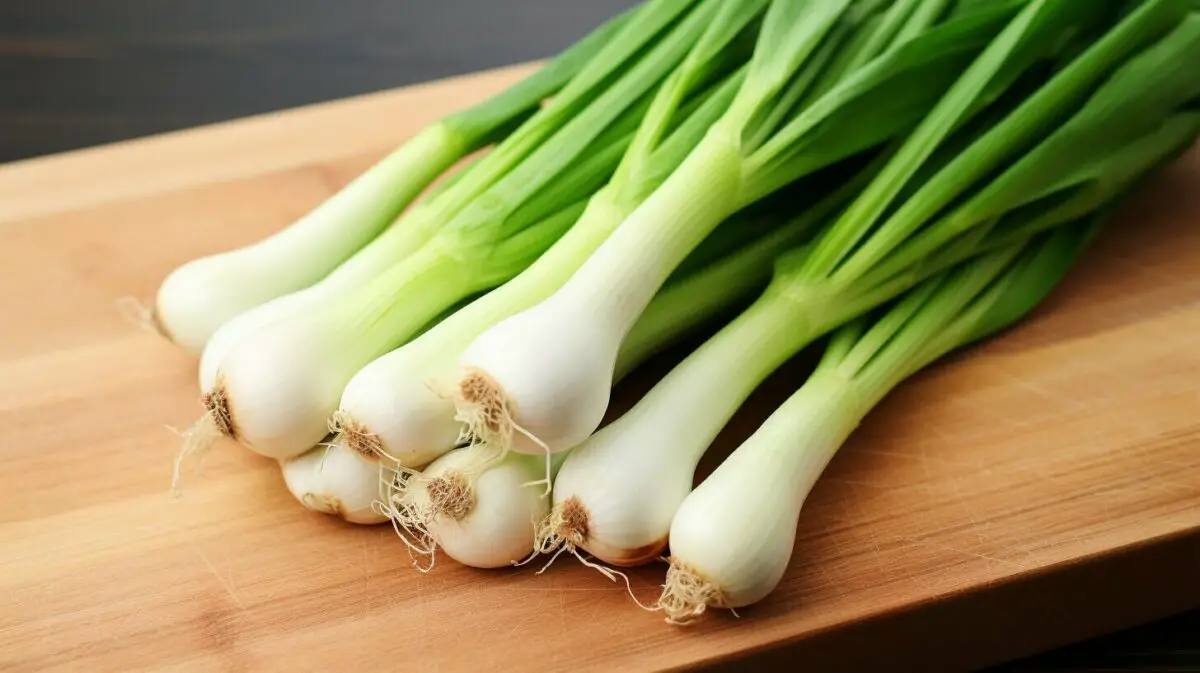
Green Onions: A Kitchen Essential
When it comes to adding a fresh and vibrant touch to your dishes, green onions are a must-have ingredient in any kitchen. With their crisp texture and mild onion flavor, they can enhance the taste and presentation of a wide range of recipes. To make the most of this versatile ingredient, it’s essential to master the different cutting methods and have the right tools at hand.
When preparing green onions, start by rinsing them under running water, ensuring they are clean and free from any dirt or debris. Next, remove any wilted pieces or bad layers, making sure only to keep the fresh and healthy parts. Trim off ¼ of an inch from both ends, getting rid of the fuzzy root end and any broken or tough green ends.
To cut green onions effectively, locate the junction where the green parts branch off from the white base. Make a clean cut at this point, separating the green and white parts. The green parts are great for garnishing, while the white parts are perfect for adding flavor to your cooking. When it comes to slicing the green parts, use a sharp knife and a gentle push-pull or circular motion to avoid breaking and bruising them.
Green onions are incredibly versatile and can be used in various dishes such as salads, soups, stir-fries, and more. Their vibrant color and delicate flavor make them not only a tasty addition but also an attractive garnish. Create beautiful garnish rings or slice them into thin strips for a visually appealing presentation.
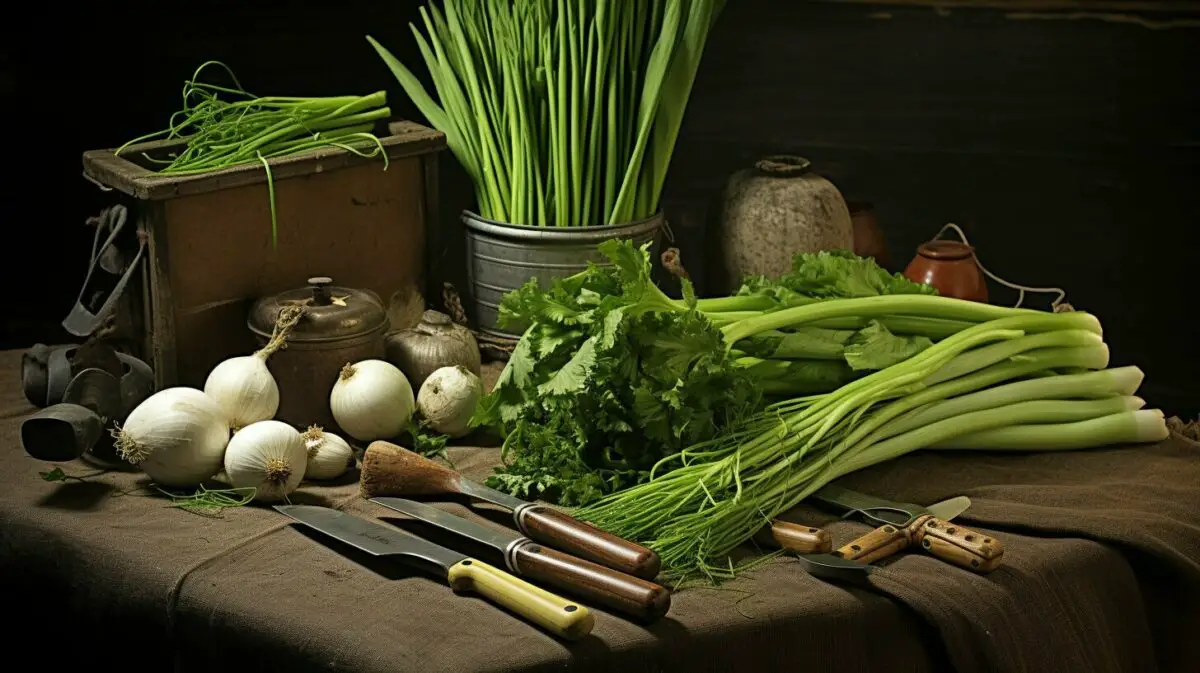
To store green onions and keep them fresh, there are a few options you can choose from. One method is to refrigerate them in a glass jar filled with water. Simply place the green onions in the jar with the root end submerged and change the water every few days to maintain freshness. Alternatively, you can wrap the green onions in a damp paper towel and place them in a plastic bag before storing them in the refrigerator. This method helps retain moisture and keeps the green onions crisp.
With these cutting methods, tips, and storage techniques in your culinary arsenal, you can confidently incorporate green onions into your cooking. Whether you’re aiming for a delicate garnish or adding a burst of flavor to your dishes, green onions are an essential ingredient that shouldn’t be overlooked.
Conclusion – How to Cut Green Onions
Now that you have learned how to cut green onions, you can confidently add this versatile ingredient to your favorite dishes. To begin, start by rinsing the green onions under running water, removing any wilted pieces or bad layers. Trim off ¼ of an inch from both ends, removing the fuzzy root end and the broken, tough green ends.
Next, locate the junction where the green parts begin to branch off from the white base and make a cut at this point. The green parts can be used for garnish, while the white parts are perfect for cooking. When slicing the green parts, use a push-pull or circular motion with a sharp knife to avoid breaking them.
Green onions can enhance the flavor and presentation of various dishes, such as salads, soups, stir-fries, and more. To store green onions, refrigerate them in a glass jar filled with water or wrap them in a damp paper towel and place them in a plastic bag. This will help maintain their freshness for longer periods.
With the knowledge and techniques shared in this guide, you are now equipped to handle green onions like a pro. So go ahead and explore the vibrant flavors and culinary possibilities that green onions bring to your cooking. Enjoy!
FAQ
Q: How should I cut green onions?
A: To cut green onions, start by rinsing them under running water and removing any wilted pieces or bad layers. Then, trim off ¼ of an inch from both ends, removing the fuzzy root end and the broken, tough green ends. Locate the junction where the green parts begin to branch off from the white base and make a cut at this point. The green parts can be used for garnish and the white parts for cooking.
Q: What is the best way to slice green onions?
A: To slice the green parts of green onions, use a push-pull or circular motion with a sharp knife to avoid breaking them. This will help create even slices for garnishing your dishes.
Q: What can I use green onions for?
A: Green onions can be used in a variety of dishes, such as salads, soups, stir-fries, and more. They add a fresh and vibrant flavor to any recipe.
Q: How should I store green onions?
A: To store green onions, you can refrigerate them in a glass jar filled with water or wrap them in a damp paper towel and place them in a plastic bag. This will help keep them fresh for longer.
Q: Are there any safety measures I should take when cutting green onions?
A: Yes, safety should always be a priority when handling knives. Make sure to use a sharp knife, keep your fingers away from the blade, and work on a stable surface to avoid accidents.
Q: What are some common mistakes to avoid when cutting green onions?
A: Some common mistakes to avoid when cutting green onions include using a dull knife, cutting too close to the root end, and not removing any wilted layers. These can affect the texture and flavor of the onions.
Q: How can I clean up after cutting green onions?
A: After cutting green onions, make sure to clean up any leftover onion bits and discard them properly. Wash your cutting board, knife, and any other utensils used in hot soapy water to remove any lingering odors.
Our Friends:
- https://www.instacart.com/company/ideas/how-to-cut-green-onions/
- https://www.acouplecooks.com/how-to-cut-green-onions/
- https://www.evolvingtable.com/how-to-cut-green-onions/
- https://www.liveeatlearn.com/how-to-cut-green-onions/
Related Recipes:
 How to Cut a Tomato? (Perfect Step-By-Step Guide)
How to Cut a Tomato? (Perfect Step-By-Step Guide)
 How to Cut Dragon Fruit? (Perfect Step-By-Step Guide)
How to Cut Dragon Fruit? (Perfect Step-By-Step Guide)
 How to Cut Mushrooms? (Perfect Step-By-Step Guide)
How to Cut Mushrooms? (Perfect Step-By-Step Guide)
 How to Chop an Onion? (Perfect Step-By-Step Guide)
How to Chop an Onion? (Perfect Step-By-Step Guide)
 How to Cut a Watermelon? (Perfect Step-By-Step Guide)
How to Cut a Watermelon? (Perfect Step-By-Step Guide)
 How to Cut Carrots? (Perfect Step-By-Step Guide)
How to Cut Carrots? (Perfect Step-By-Step Guide)
 How to Cut Beets? (Perfect Step-By-Step Guide)
How to Cut Beets? (Perfect Step-By-Step Guide)
 How to Cut Shallots? (Perfect Step-By-Step Guide)
How to Cut Shallots? (Perfect Step-By-Step Guide)








